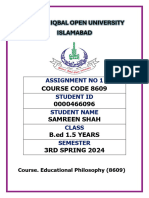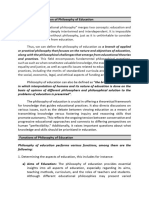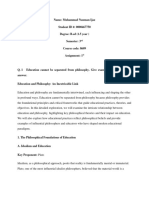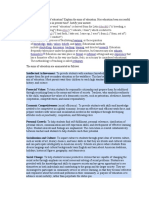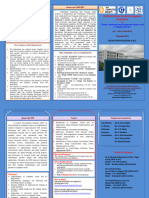0 ratings0% found this document useful (0 votes)
0 viewsAllama Iqbal Open University
Allama Iqbal Open University
Uploaded by
abbub590Copyright:
© All Rights Reserved
Available Formats
Download as PDF, TXT or read online from Scribd
Allama Iqbal Open University
Allama Iqbal Open University
Uploaded by
abbub5900 ratings0% found this document useful (0 votes)
0 views19 pagesOriginal Title
8609-1
Copyright
© © All Rights Reserved
Available Formats
PDF, TXT or read online from Scribd
Share this document
Did you find this document useful?
Is this content inappropriate?
Copyright:
© All Rights Reserved
Available Formats
Download as PDF, TXT or read online from Scribd
Download as pdf or txt
0 ratings0% found this document useful (0 votes)
0 views19 pagesAllama Iqbal Open University
Allama Iqbal Open University
Uploaded by
abbub590Copyright:
© All Rights Reserved
Available Formats
Download as PDF, TXT or read online from Scribd
Download as pdf or txt
You are on page 1of 19
ALLAMA IQBAL OPEN UNIVERSITY
NAME: Zobia Sagheer
ID NO: 0000459253
PROGRAM: B.ed
COURSE CODE: (8609)
SEMESTER: Spring 2024
ASSIGNMENT NO:1
Q. 1 Education cannot be separated from philosophy.
Give examples to support your answer. (20)
Education cannot be separated from philosophy:
Education and philosophy are intertwined and inseparable.
Philosophy is the foundation of education, as it provides the
framework for understanding the nature of knowledge, reality,
and human existence. Here are some examples to support this
statement:
1. Curriculum Development: Philosophy influences the
development of curriculum, as it shapes the way we think
about what students should learn and how they should
learn it. For example, a curriculum that emphasizes critical
thinking and problem-solving skills is rooted in
philosophical concepts such as pragmatism and
existentialism.
2. Teaching Methods: Philosophical theories inform teaching
methods, such as constructivism, which emphasizes
student-centered learning and active participation. This
approach is based on the philosophical idea that
knowledge is constructed by individuals rather than being
transmitted by authority.
3. Assessment and Evaluation: Philosophy impacts the way
we assess and evaluate student learning. For example, a
philosophy that emphasizes student autonomy and self-
directed learning may lead to more flexible and student-
centered assessment methods.
4. Values and Ethics: Philosophy informs the values and
ethics that guide education. For example, a philosophical
perspective that emphasizes social justice may lead to
curricula that focus on addressing issues of inequality and
promoting social change.
5. Teacher-Student Relationships: Philosophy shapes the
way teachers interact with students, influencing their
relationships and pedagogical approaches. For example, a
philosophy that emphasizes empathy and compassion may
lead to more nurturing and supportive teacher-student
relationships.
6. Learning Theories: Philosophical theories underlie many
learning theories, such as behaviorism, constructivism,
and social constructivism. These theories inform our
understanding of how students learn and how we can best
support their learning.
7. Critical Thinking: Philosophy is essential for developing
critical thinking skills in students. Critical thinking is a
philosophical concept that involves analyzing information,
evaluating arguments, and making informed decisions.
Education and philosophy are intimately connected, as
philosophical principles and concepts shape educational theories,
practices, and goals. Here are some examples:
1. Epistemology: The study of knowledge and belief influences
how we approach teaching and learning. For instance, a
teacher’s epistemological stance on the nature of knowledge
will impact their approach to curriculum design and
assessment.
2. Ethics: Philosophical ethical theories guide decision-making
in education, such as debates on inclusivity, diversity, and
social justice.
3. Metaphysics: Beliefs about reality and human nature inform
educational aims, like preparing students for a rapidly
changing world or focusing on personal growth.
4. Logic and Critical Thinking: Philosophical methods for
reasoning and argumentation are essential skills taught in
education.
5. Political Philosophy: Ideas on governance, power, and
citizenship shape educational policies and practices, such as
democratic education or critical pedagogy.
6. Philosophy of Mind: Understanding the nature of the mind
and consciousness informs teaching methods, like cognitive
development or mindfulness practices.
7. Aesthetics: Philosophical perspectives on beauty, taste, and
art influence arts education and appreciation.
8. Philosophy of Science: The study of scientific inquiry and
methodology informs science education and critical
thinking.
9. Social and Political Philosophy: Concepts like justice,
equality, and freedom shape educational goals and practices,
such as multicultural education or social justice pedagogy.
10. Philosophy of Education: Philosophers like Plato,
Dewey, and Freire have shaped educational thought and
practice, influencing teaching methods and educational
policies.
These examples illustrate how philosophy permeates various
aspects of education, making it an integral part of the educational
endeavor.
Conclusion:
In conclusion, education cannot be separated from philosophy.
Philosophy informs every aspect of education, from curriculum
development to teaching methods, assessment and evaluation,
values and ethics, teacher-student relationships, learning theories,
and critical thinking. By acknowledging the interdependence of
education and philosophy, educators can better understand the
complexities of teaching and learning and make more informed
decisions about how to support student success.
Q. 2How does ‘idealism’ impact different areas of
education, Discuss. (20)
Impact of Idealism on Education:
Idealism is a philosophical approach that emphasizes the
importance of ideas, values, and moral principles in education. It
has a significant impact on various aspects of education,
including:
1. Curriculum Development: Idealism influences the curriculum
development process, focusing on the transmission of values,
morals, and ideals. This approach emphasizes the importance of
teaching students about abstract concepts such as justice, equality,
and freedom.
2. Teaching Methods: Idealistic teachers often adopt a more
directive approach, using lectures, discussions, and debates to
convey their ideas and values. This method encourages critical
thinking and analysis of complex issues.
3. Assessment and Evaluation: Idealistic educators may focus on
assessing students’ understanding of abstract concepts and their
ability to apply them in real-world situations. This approach
values depth over breadth, prioritizing meaningful learning over
mere memorization.
4. Teacher-Student Relationships: Idealistic teachers often
prioritize building strong relationships with students, fostering a
sense of community and trust. This approach encourages students
to feel comfortable exploring complex ideas and expressing their
opinions.
5. Learning Environment: Idealistic educators often create a
learning environment that promotes critical thinking, creativity,
and inquiry. This includes encouraging students to question
authority, challenge assumptions, and explore different
perspectives.
6. Student-Centered Learning: Idealism emphasizes student-
centered learning, where students take an active role in their
learning process. This approach encourages students to engage in
self-directed learning, problem-solving, and critical thinking.
7. Emphasis on Theory: Idealistic educators often focus on
theoretical concepts, such as ethics, morality, and social justice.
This approach prepares students to think critically about complex
issues and make informed decisions.
8. Values Education: Idealism places a strong emphasis on values
education, teaching students about important values such as
empathy, compassion, and respect for diversity.
9. Inquiry-Based Learning: Idealistic educators often use inquiry-
based learning approaches, which encourage students to explore
questions and problems through critical thinking and analysis.
10. Focus on Social Responsibility: Idealism emphasizes the
importance of social responsibility, encouraging students to
become engaged citizens who contribute to the betterment of
society.
Conclusion:
In conclusion, idealism has a significant impact on various
aspects of education, including curriculum development, teaching
methods, assessment and evaluation, teacher-student
relationships, learning environment, student-centered learning,
emphasis on theory, values education, inquiry-based learning, and
focus on social responsibility. By embracing idealism in
education, we can foster a more critical and compassionate
society that values knowledge, ethics, and social responsibility.
Q. 3Define and explain ‘Pragmatism’ as a modern
philosophy which has reshaped educational policy and
practices. (20)
Pragmatism: A Modern Philosophy Shaping Education
Pragmatism is a modern philosophical movement that emphasizes
practicality, experience, and experimentation in understanding
the world. In education, pragmatism has reshaped policy and
practices by focusing on student-centered learning, hands-on
experiences, and problem-solving. Here’s a definition and
explanation of pragmatism’s impact on education:
Definition: Pragmatism is a philosophical approach that
emphasizes the practical application of knowledge and ideas. It
rejects the idea of absolute truth and instead focuses on the
usefulness and effectiveness of knowledge in solving problems
and improving human experiences.
Key Principles:
1. Practice over Theory: Pragmatism prioritizes practical
experience and experimentation over abstract theories and
dogmatic beliefs.
2. Student-Centered Learning: Pragmatism emphasizes student-
centered learning, where students take an active role in their
learning process and are encouraged to explore and discover
concepts.
3. Hands-on Experiences: Pragmatism values hands-on
experiences and real-world applications of knowledge, allowing
students to connect abstract concepts to concrete situations.
4. Problem-Solving: Pragmatism encourages students to engage
in problem-solving and critical thinking, developing skills that are
essential for real-world applications.
5. Emphasis on Inquiry: Pragmatism emphasizes the importance
of inquiry and investigation, encouraging students to explore
questions and topics through experimentation and analysis.
Impact on Education:
1. Curriculum Development: Pragmatism has led to the
development of curriculum frameworks that focus on hands-on
learning, problem-solving, and critical thinking.
2. Teaching Methods: Pragmatist teachers often adopt more
flexible and adaptive approaches, using simulations, role-playing,
and project-based learning to engage students.
3. Assessment and Evaluation: Pragmatist educators may focus
on assessing student learning through projects, presentations, and
performances, rather than traditional written tests.
4. Teacher-Student Relationships: Pragmatist teachers often
prioritize building strong relationships with students, fostering a
sense of trust and encouraging student autonomy.
5. Learning Environment: Pragmatist educators often create a
learning environment that is flexible, collaborative, and open to
experimentation, allowing students to explore and learn in a
dynamic setting.
Conclusion:
In conclusion, pragmatism has reshaped educational policy and
practices by emphasizing student-centered learning, hands-on
experiences, problem-solving, inquiry-based learning, and
practical application of knowledge. By adopting pragmatist
principles, educators can create a more engaging, effective, and
relevant learning environment that prepares students for the
complexities of the modern world.
Q. 4Briefly discuss different sources of knowledge
from prehistoric to modern day world. (20)
Sources of Knowledge: From Prehistoric to Modern Day
Throughout history, humans have developed various sources of
knowledge to understand the world and their place in it. Here’s a
brief overview of the different sources of knowledge from
prehistoric to modern day:
Prehistoric Era (Before 3000 BCE):
1. Oral Tradition: Storytelling, myths, and legends passed down
through generations by word of mouth.
2. Observation and Intuition: People learned from their
surroundings, observing patterns and making connections
through intuition.
Ancient Civilizations (3000 BCE – 500 CE):
1. Divine Revelation: Gods and goddesses were believed to
communicate knowledge through prophets, scriptures, or oracles.
2. Written Records: Written texts, such as hieroglyphics,
cuneiform, and papyrus, preserved knowledge and stories.
3. Empirical Observation: Scientists like Aristotle and Galen
conducted experiments and observations to understand the natural
world.
Middle Ages (500 CE – 1500 CE):
1. Scripture and Authority: The Bible and other sacred texts were
considered the primary source of knowledge.
2. Scholasticism: Scholars like Thomas Aquinas combined faith
and reason to develop a system of knowledge.
Modern Era (1500 CE – 2000 CE):
1. Science and Experimentation: The scientific method,
developed by Francis Bacon, emphasized empirical observation,
experimentation, and peer review.
2. Reasoning and Logic: The Enlightenment emphasized the
power of human reason and logic in understanding the world.
3. Empirical Research: The scientific method continued to evolve,
with an emphasis on empirical research and data-driven
conclusions.
Contemporary Era (2000 CE – Present):
1. Digital Sources: The internet, social media, and online
resources have become a primary source of information.
2. Interdisciplinary Research: Researchers from diverse fields
collaborate to address complex problems, integrating knowledge
from multiple disciplines.
3. Data-Driven Decision Making: Data analytics and evidence-
based decision-making have become increasingly important in
various fields.
Conclusion:
Throughout human history, various sources of knowledge have
emerged, reflecting the cultural, social, and technological
advancements of each era. From oral tradition to digital sources,
our understanding of the world has evolved significantly, shaped
by the collective efforts of humans seeking knowledge.
Q. 5Compare and contrast ‘empirical’ knowledge with
other sources of knowledge. (20)
Empirical Knowledge: A Comparison and Contrast with Other
Sources of Knowledge
Empirical knowledge is a type of knowledge that is acquired
through observation, experience, and experimentation. In this
answer, we will compare and contrast empirical knowledge with
other sources of knowledge, including:
Empirical Knowledge:
1. Acquired through Observation and Experience: Empirical
knowledge is gained through direct observation and hands-on
experience.
2. Based on Evidence: Empirical knowledge is based on empirical
evidence, which is verifiable and falsifiable.
3. Subject to Revision: Empirical knowledge is subject to revision
as new evidence emerges.
Comparison with Other Sources of Knowledge:
1. Rational Knowledge: Rational knowledge is acquired through
reason and logic, rather than observation and experience.
Examples include mathematical truths and philosophical
principles.
2. Authoritative Knowledge: Authoritative knowledge is acquired
through the authority of experts, such as religious texts or the
teachings of great leaders.
3. Intuitive Knowledge: Intuitive knowledge is acquired through
intuition, instinct, or gut feelings, often without conscious
reasoning.
Contrast with Other Sources of Knowledge:
1. Empirical Knowledge vs. Rational Knowledge: Empirical
knowledge is based on evidence, whereas rational knowledge is
based on reason and logic.
2. Empirical Knowledge vs. Authoritative Knowledge: Empirical
knowledge is subject to revision, whereas authoritative
knowledge is often seen as absolute and unchangeable.
3. Empirical Knowledge vs. Intuitive Knowledge: Empirical
knowledge is based on observation and experience, whereas
intuitive knowledge is based on instinct or gut feelings.
Key Points:
Empirical knowledge is a specific type of knowledge that is
acquired through observation, experience, and experimentation.
It is distinct from other sources of knowledge, such as rational,
authoritative, and intuitive knowledge.
Empirical knowledge is subject to revision as new evidence
emerges, whereas other sources of knowledge may be more fixed
or absolute.
Conclusion:
In conclusion, empirical knowledge is a unique type of
knowledge that is acquired through observation and experience.
While it shares similarities with other sources of knowledge, such
as rational and authoritative knowledge, it is distinct in its reliance
on empirical evidence and its potential for revision as new
evidence emerges.
The End
You might also like
- (PDF Download) P.O.W.E.R. Learning: Strategies For Success in College and Life Feldman Fulll ChapterDocument64 pages(PDF Download) P.O.W.E.R. Learning: Strategies For Success in College and Life Feldman Fulll Chapterxhunhameau100% (3)
- Delm112-Social, Psychological, and Philosophical Issues in EducationDocument10 pagesDelm112-Social, Psychological, and Philosophical Issues in EducationSonny Matias100% (3)
- 8609.01 Unique-1Document25 pages8609.01 Unique-1haziqNo ratings yet
- Samreen Shah 8609Document32 pagesSamreen Shah 8609Ali MuradNo ratings yet
- Why Understand The Philosophical Foundations of EducationDocument6 pagesWhy Understand The Philosophical Foundations of EducationGeraldine BallesNo ratings yet
- Philosophical Factors Affecting Educational Planning-1Document9 pagesPhilosophical Factors Affecting Educational Planning-1Moona UmerNo ratings yet
- Student Name: Zainab Course Code: 8609 Roll No. 0000495995 Semester: 3Document16 pagesStudent Name: Zainab Course Code: 8609 Roll No. 0000495995 Semester: 3Zainab KNo ratings yet
- Assignment #01: Subject: Philosophy of Education Course Code (8609)Document14 pagesAssignment #01: Subject: Philosophy of Education Course Code (8609)Engr SobiaNo ratings yet
- B.Ed 102Document44 pagesB.Ed 102vogedi5897No ratings yet
- Unique 8609 - 1Document29 pagesUnique 8609 - 1Muhammad Saddique AkbarNo ratings yet
- Nazreen Kousar (8609) Assignment 1 PDFDocument31 pagesNazreen Kousar (8609) Assignment 1 PDFkamrankiani789No ratings yet
- General Method of TeachingDocument10 pagesGeneral Method of TeachingHijab BatoolNo ratings yet
- 8609 AssignmentDocument9 pages8609 AssignmentIts wishNo ratings yet
- Definition of Philosophy of EducationDocument6 pagesDefinition of Philosophy of Educationazizaemad446No ratings yet
- Introduction To Educational PhilosophyDocument23 pagesIntroduction To Educational PhilosophyMega MindNo ratings yet
- M Bilal Tariq 8609-1Document41 pagesM Bilal Tariq 8609-1bilalheera345No ratings yet
- 8609 Important Questions A23 M.JABERDocument32 pages8609 Important Questions A23 M.JABERmeharmarehman87No ratings yet
- Assignment Related AiouDocument11 pagesAssignment Related AiouShaxi NaximNo ratings yet
- Critical PedagogyDocument5 pagesCritical PedagogyMisbah TahirNo ratings yet
- Ornstein'S Philosophy As A Basis For Curriculul DevelopmentDocument3 pagesOrnstein'S Philosophy As A Basis For Curriculul DevelopmentJerameel Mangubat ArabejoNo ratings yet
- Philosophy of Eductaion 2Document51 pagesPhilosophy of Eductaion 2skyharmoonizNo ratings yet
- assDocument4 pagesassWahab AftabNo ratings yet
- Foundations of CurriculumDocument24 pagesFoundations of CurriculumCharlene PortugalNo ratings yet
- Lesson Two ADocument13 pagesLesson Two ARenick WanyonyiNo ratings yet
- Allama Iqbal Open University: Assignment No 1Document20 pagesAllama Iqbal Open University: Assignment No 1Ahsan NangrajNo ratings yet
- 12 PhilosophiesDocument4 pages12 PhilosophiesHoney Ghemmalyn Abalos100% (1)
- Edu 101Document8 pagesEdu 101khngs liteNo ratings yet
- JETIR2401066Document4 pagesJETIR2401066Mehak 3109No ratings yet
- 8609 Assignment 1Document20 pages8609 Assignment 1aamirshehzad1383010No ratings yet
- Philosophical Consideration of Curriculum Theories and ApproachesDocument4 pagesPhilosophical Consideration of Curriculum Theories and ApproachesWhy D. Hell-NotNo ratings yet
- Unit IDocument14 pagesUnit Ihazel ann canejaNo ratings yet
- Essay in Ed202 Unit3Document6 pagesEssay in Ed202 Unit3Madel May D EgeraNo ratings yet
- Focuses On The Teaching of Great Works.Document4 pagesFocuses On The Teaching of Great Works.maela pollen yemaNo ratings yet
- (8609) 1st Assignment RIZWANDocument33 pages(8609) 1st Assignment RIZWANmr.manzoor1965No ratings yet
- Philosophies Intro.Document3 pagesPhilosophies Intro.Charmie JaviertoNo ratings yet
- 8609 1stDocument39 pages8609 1sttehseenijaz05No ratings yet
- 8609 (Neiha Shabir Assginment - 1)Document17 pages8609 (Neiha Shabir Assginment - 1)Neiha ShabirNo ratings yet
- Unit 2 Curriculum As A Field of StudyDocument28 pagesUnit 2 Curriculum As A Field of Studykevinthefuture50No ratings yet
- Curriculum Development First Milestone İlayda-Zeynep-Öykü-BartuDocument3 pagesCurriculum Development First Milestone İlayda-Zeynep-Öykü-BartutanktufekNo ratings yet
- Relevance of Educational Philosophy To The Teaching-Learning ProcessDocument2 pagesRelevance of Educational Philosophy To The Teaching-Learning Processaliely gumbanNo ratings yet
- Group 5 Advanced PhilosophyDocument25 pagesGroup 5 Advanced Philosophyeugene louie ibarraNo ratings yet
- Mes 012Document11 pagesMes 012ramNo ratings yet
- Essay On Philosophical Foundations of EducationDocument2 pagesEssay On Philosophical Foundations of EducationJes Espago VillaramNo ratings yet
- AssignmentDocument10 pagesAssignmentgeydelerNo ratings yet
- Foundations of CurriculumDocument9 pagesFoundations of Curriculumpaul kapambweNo ratings yet
- BTE2601 Assignment 2 2024Document9 pagesBTE2601 Assignment 2 2024jametrabuckles102No ratings yet
- Discuss Comprehensively - Foundations of EducationDocument2 pagesDiscuss Comprehensively - Foundations of Educationjoseestoleros2022No ratings yet
- Module III NOtesDocument13 pagesModule III NOtesApoorva MitraNo ratings yet
- Educations For Foundations 2 PhilosophyDocument12 pagesEducations For Foundations 2 PhilosophyAugustus EliaNo ratings yet
- Philosophical Foundations.1-6Document6 pagesPhilosophical Foundations.1-6Pakiza's SadiqNo ratings yet
- PhilosophyDocument4 pagesPhilosophyKristia Mae CellonaNo ratings yet
- What Is The Meaning of EducationDocument3 pagesWhat Is The Meaning of EducationVenz Timothy Wesley LandichoNo ratings yet
- Name: Kashif Ali Student ID: 0000357315 Course ID: 8612 Subject: Professionalism in Teaching Tutor: Abdul Karim Assignment # 2Document12 pagesName: Kashif Ali Student ID: 0000357315 Course ID: 8612 Subject: Professionalism in Teaching Tutor: Abdul Karim Assignment # 2najeebrehman0088No ratings yet
- Educational PhilosophyDocument2 pagesEducational PhilosophyRondy VillanuevaNo ratings yet
- 8609 Assignment No 1-2-16Document15 pages8609 Assignment No 1-2-16neravod884No ratings yet
- Ghulam Mustafa 8609Document38 pagesGhulam Mustafa 8609GM raimaths techNo ratings yet
- PED 9 Module 3Document10 pagesPED 9 Module 3Greta SuNo ratings yet
- AIOUDocument13 pagesAIOUdaily live0% (1)
- Various Philosophies of EducationDocument14 pagesVarious Philosophies of Educationpempleo254No ratings yet
- Script and ExplanationDocument6 pagesScript and ExplanationThecla KleioNo ratings yet
- Mastering the Art of Teaching: A Comprehensive Guide to Becoming an Exceptional EducatorFrom EverandMastering the Art of Teaching: A Comprehensive Guide to Becoming an Exceptional EducatorNo ratings yet
- ET Hall - The Hidden Dimension PDFDocument126 pagesET Hall - The Hidden Dimension PDFVictor StoicaNo ratings yet
- HDF 492-Aidan Votaw Portfolio FinalDocument10 pagesHDF 492-Aidan Votaw Portfolio Finalapi-491772928No ratings yet
- Blueback What Is Ocean Literacy Week 2-Student Worksheet 1Document4 pagesBlueback What Is Ocean Literacy Week 2-Student Worksheet 1api-314003507No ratings yet
- Consumer Perception: Amity Business SchoolDocument31 pagesConsumer Perception: Amity Business SchoolHimanshu SachdevaNo ratings yet
- Perverse Triangles in Family Systems Theory: Name of ConceptDocument3 pagesPerverse Triangles in Family Systems Theory: Name of ConceptDiana Radut-SelisteNo ratings yet
- A Teacher CreedDocument5 pagesA Teacher CreedJerson Dela TorreNo ratings yet
- The Machine Learning LandscapeDocument25 pagesThe Machine Learning LandscapeNaman AgrawalNo ratings yet
- Art ReflectionDocument3 pagesArt ReflectionSri RahayuNo ratings yet
- 3 Act Task Template: Lead4ward Texas GatewayDocument2 pages3 Act Task Template: Lead4ward Texas GatewayAnaliesa LopezNo ratings yet
- I Dedicated This Research To My Family Who Had Supported Me Throughout The ResearchDocument10 pagesI Dedicated This Research To My Family Who Had Supported Me Throughout The ResearchMarilyn RebatoNo ratings yet
- Transactional Idiom Analysis Theory and Practice LiontasDocument6 pagesTransactional Idiom Analysis Theory and Practice LiontasMarinaCelesteNo ratings yet
- Counselling in The Work PlaceDocument12 pagesCounselling in The Work PlaceROKOV ZHASANo ratings yet
- AcknowledgmentDocument7 pagesAcknowledgmentSANGEET VERMANo ratings yet
- Aida ModelDocument14 pagesAida ModelNayla SalsabilaNo ratings yet
- BC July'24Document5 pagesBC July'24harshalrv33No ratings yet
- The Safety Net CurriculumDocument4 pagesThe Safety Net Curriculumvicky_sharma0007_832No ratings yet
- Discuss What It Means To Be Socially Responsible and What Factors Influence That DecisionDocument4 pagesDiscuss What It Means To Be Socially Responsible and What Factors Influence That DecisionZara AsrarNo ratings yet
- David Kinnersley: ResumeDocument2 pagesDavid Kinnersley: Resumeapi-294882880No ratings yet
- Lesson 19 20Document14 pagesLesson 19 20G spotNo ratings yet
- Fearlessness in Preschoolers: An Extreme End of The Approach and Withdrawal Temperamental DimensionDocument232 pagesFearlessness in Preschoolers: An Extreme End of The Approach and Withdrawal Temperamental DimensionvkeylinNo ratings yet
- Statements of Inquiry in Language AcquisitionDocument4 pagesStatements of Inquiry in Language AcquisitionSonal BhatiaNo ratings yet
- ChatGPT For SLPs ResourceDocument6 pagesChatGPT For SLPs ResourceprincessimeemoralessacbibitNo ratings yet
- FDB Brochure - Deep Learning For Computer Vision From 05.02.2024 To 10.02.2024Document2 pagesFDB Brochure - Deep Learning For Computer Vision From 05.02.2024 To 10.02.2024publicationNo ratings yet
- DLL C.writing Week 6Document3 pagesDLL C.writing Week 6Gerald Rosario FerrerNo ratings yet
- Holiday Assignment: Shanti Asiatic SchoolDocument2 pagesHoliday Assignment: Shanti Asiatic Schoolsunil prasadNo ratings yet
- Mixed Tenses ExerciseDocument3 pagesMixed Tenses ExerciseFi WongNo ratings yet
- Moreno FS2 Module CP7Document6 pagesMoreno FS2 Module CP7macmmorenoNo ratings yet
- Three Modes of Communication PDFDocument2 pagesThree Modes of Communication PDFmoonxstarNo ratings yet
- Project Synopsis Template For MbaDocument4 pagesProject Synopsis Template For MbaSushanthNo ratings yet



